2020 Hyundai Tucson load capacity
[x] Cancel search: load capacityPage 316 of 637
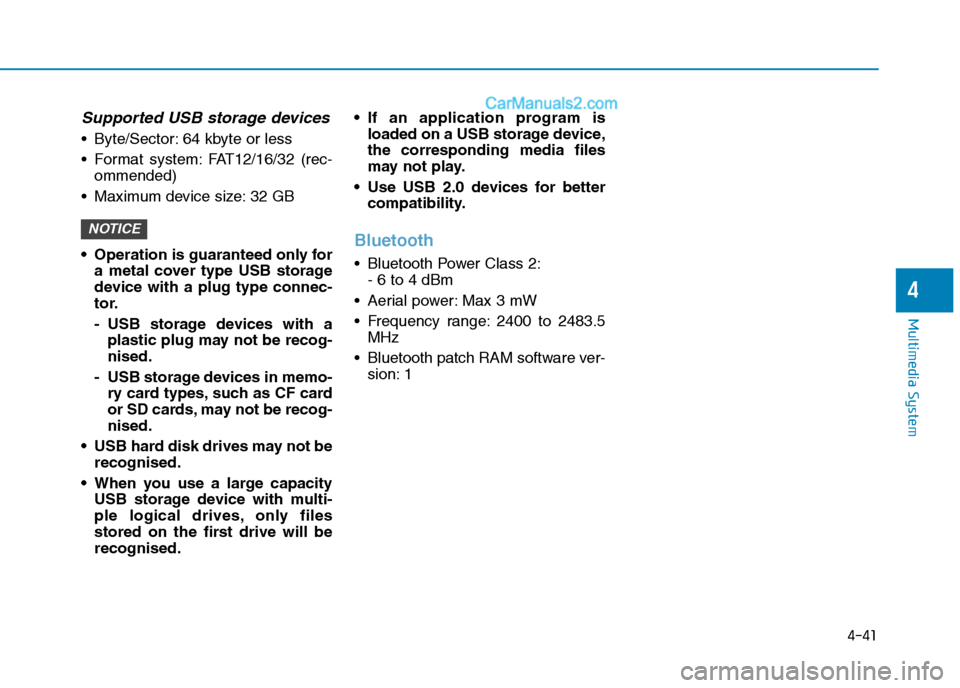
4-41
Multimedia System
4
Supported USB storage devices
Byte/Sector: 64 kbyte or less
Format system: FAT12/16/32 (rec-
ommended)
Maximum device size: 32 GB
Operation is guaranteed only for
a metal cover type USB storage
device with a plug type connec-
tor.
- USB storage devices with a
plastic plug may not be recog-
nised.
- USB storage devices in memo-
ry card types, such as CF card
or SD cards, may not be recog-
nised.
USB hard disk drives may not be
recognised.
When you use a large capacity
USB storage device with multi-
ple logical drives, only files
stored on the first drive will be
recognised. If an application program is
loaded on a USB storage device,
the corresponding media files
may not play.
Use USB 2.0 devices for better
compatibility.
Bluetooth
Bluetooth Power Class 2:
- 6 to 4 dBm
Aerial power: Max 3 mW
Frequency range: 2400 to 2483.5
MHz
Bluetooth patch RAM software ver-
sion: 1
NOTICE
Page 389 of 637
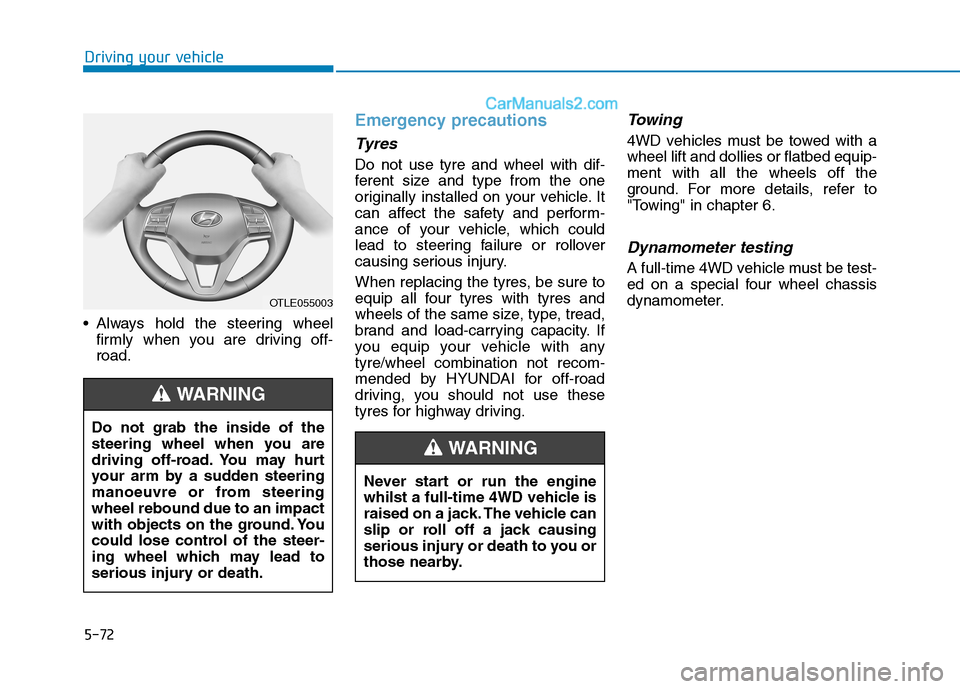
5-72
Driving your vehicle
Always hold the steering wheel
firmly when you are driving off-
road.
Emergency precautions
Tyres
Do not use tyre and wheel with dif-
ferent size and type from the one
originally installed on your vehicle. It
can affect the safety and perform-
ance of your vehicle, which could
lead to steering failure or rollover
causing serious injury.
When replacing the tyres, be sure to
equip all four tyres with tyres and
wheels of the same size, type, tread,
brand and load-carrying capacity. If
you equip your vehicle with any
tyre/wheel combination not recom-
mended by HYUNDAI for off-road
driving, you should not use these
tyres for highway driving.
Towing
4WD vehicles must be towed with a
wheel lift and dollies or flatbed equip-
ment with all the wheels off the
ground. For more details, refer to
"Towing" in chapter 6.
Dynamometer testing
A full-time 4WD vehicle must be test-
ed on a special four wheel chassis
dynamometer.
OTLE055003
Do not grab the inside of the
steering wheel when you are
driving off-road. You may hurt
your arm by a sudden steering
manoeuvre or from steering
wheel rebound due to an impact
with objects on the ground. You
could lose control of the steer-
ing wheel which may lead to
serious injury or death.
WARNING
Never start or run the engine
whilst a full-time 4WD vehicle is
raised on a jack. The vehicle can
slip or roll off a jack causing
serious injury or death to you or
those nearby.
WARNING
Page 391 of 637
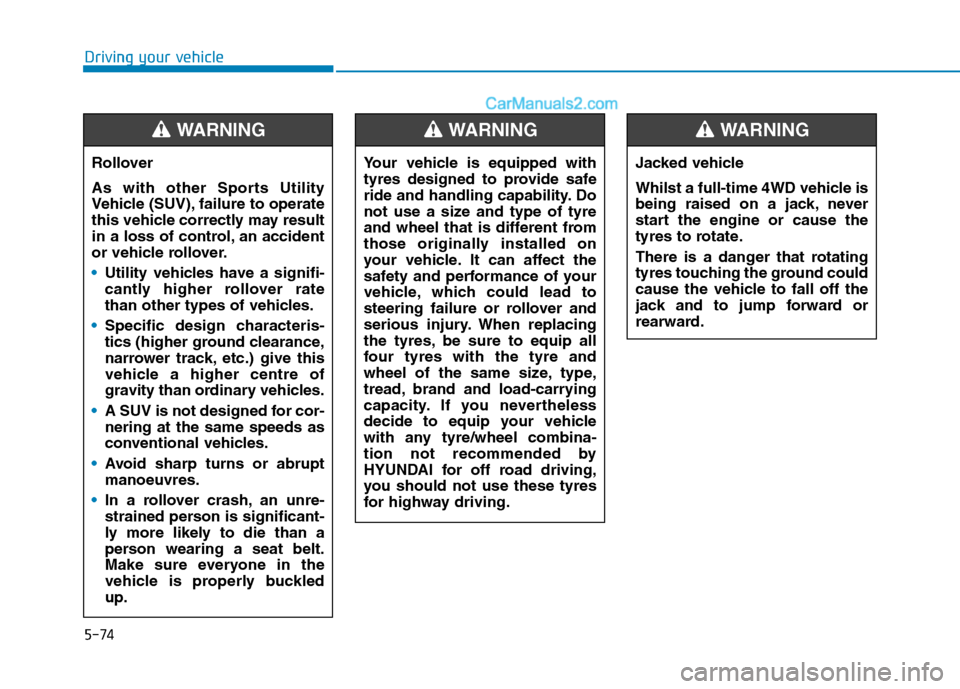
5-74
Driving your vehicle
Rollover
As with other Sports Utility
Vehicle (SUV), failure to operate
this vehicle correctly may result
in a loss of control, an accident
or vehicle rollover.
Utility vehicles have a signifi-
cantly higher rollover rate
than other types of vehicles.
Specific design characteris-
tics (higher ground clearance,
narrower track, etc.) give this
vehicle a higher centre of
gravity than ordinary vehicles.
A SUV is not designed for cor-
nering at the same speeds as
conventional vehicles.
Avoid sharp turns or abrupt
manoeuvres.
In a rollover crash, an unre-
strained person is significant-
ly more likely to die than a
person wearing a seat belt.
Make sure everyone in the
vehicle is properly buckled
up.
WARNING
Your vehicle is equipped with
tyres designed to provide safe
ride and handling capability. Do
not use a size and type of tyre
and wheel that is different from
those originally installed on
your vehicle. It can affect the
safety and performance of your
vehicle, which could lead to
steering failure or rollover and
serious injury. When replacing
the tyres, be sure to equip all
four tyres with the tyre and
wheel of the same size, type,
tread, brand and load-carrying
capacity. If you nevertheless
decide to equip your vehicle
with any tyre/wheel combina-
tion not recommended by
HYUNDAI for off road driving,
you should not use these tyres
for highway driving.
WARNING
Jacked vehicle
Whilst a full-time 4WD vehicle is
being raised on a jack, never
start the engine or cause the
tyres to rotate.
There is a danger that rotating
tyres touching the ground could
cause the vehicle to fall off the
jack and to jump forward or
rearward.
WARNING
Page 480 of 637
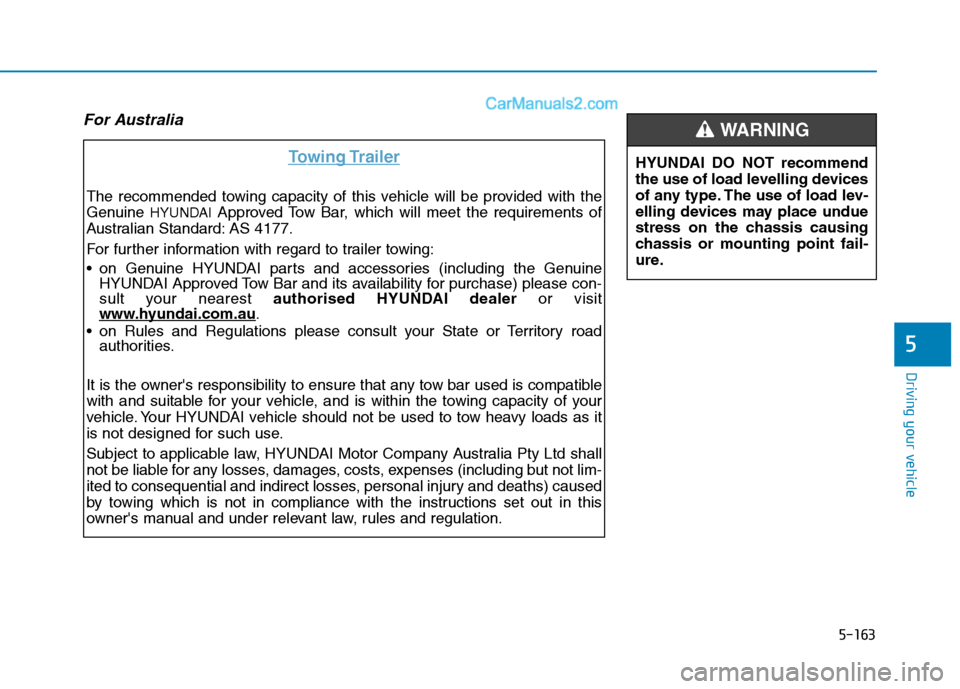
5-163
Driving your vehicle
5
For Australia
Towing Trailer
The recommended towing capacity of this vehicle will be provided with the
Genuine
HYUNDAIApproved Tow Bar, which will meet the requirements of
Australian Standard: AS 4177.
For further information with regard to trailer towing:
on Genuine HYUNDAI parts and accessories (including the Genuine
HYUNDAI Approved Tow Bar and its availability for purchase) please con-
sult your nearest authorised HYUNDAI dealeror visit
www
.hyundai.com.au.
on Rules and Regulations please consult your State or Territory road
authorities.
It is the owner's responsibility to ensure that any tow bar used is compatible
with and suitable for your vehicle, and is within the towing capacity of your
vehicle. Your HYUNDAI vehicle should not be used to tow heavy loads as it
is not designed for such use.
Subject to applicable law, HYUNDAI Motor Company Australia Pty Ltd shall
not be liable for any losses, damages, costs, expenses (including but not lim-
ited to consequential and indirect losses, personal injury and deaths) caused
by towing which is not in compliance with the instructions set out in this
owner's manual and under relevant law, rules and regulation.
HYUNDAI DO NOT recommend
the use of load levelling devices
of any type. The use of load lev-
elling devices may place undue
stress on the chassis causing
chassis or mounting point fail-
ure.
WARNING
Page 481 of 637
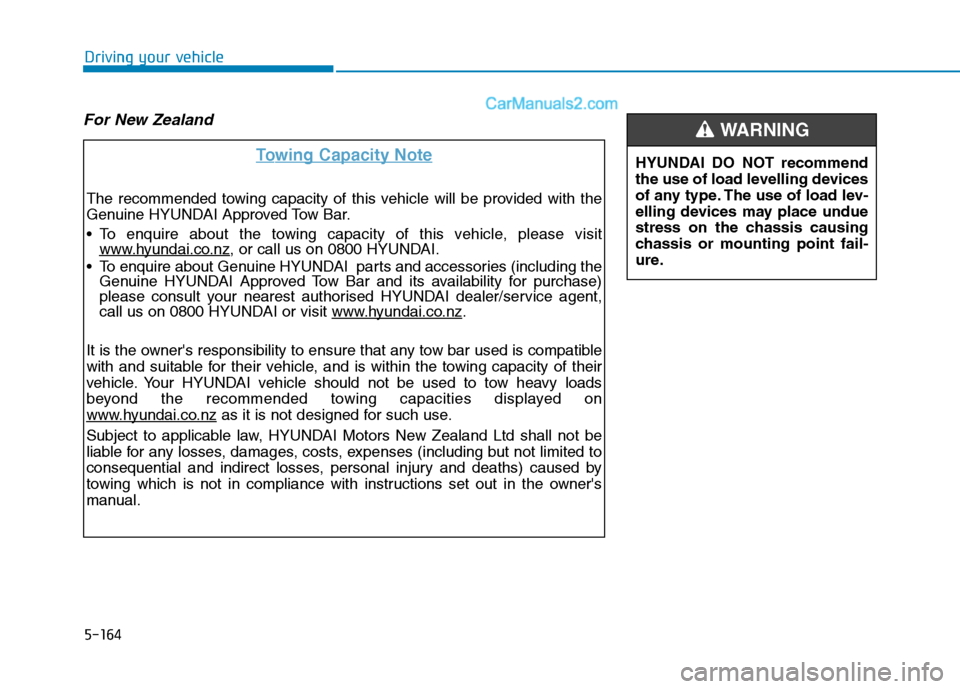
5-164
Driving your vehicle
For New Zealand
Towing Capacity Note
The recommended towing capacity of this vehicle will be provided with the
Genuine HYUNDAI Approved Tow Bar.
To enquire about the towing capacity of this vehicle, please visit
www
.hyundai.co.nz, or call us on 0800 HYUNDAI.
To enquire about Genuine HYUNDAI parts and accessories (including the
Genuine HYUNDAI Approved Tow Bar and its availability for purchase)
please consult your nearest authorised HYUNDAI dealer/service agent,
call us on 0800 HYUNDAI or visit www
.hyundai.co.nz.
It is the owner's responsibility to ensure that any tow bar used is compatible
with and suitable for their vehicle, and is within the towing capacity of their
vehicle. Your HYUNDAI vehicle should not be used to tow heavy loads
beyond the recommended towing capacities displayed on
www
.hyundai.co.nzas it is not designed for such use.
Subject to applicable law, HYUNDAI Motors New Zealand Ltd shall not be
liable for any losses, damages, costs, expenses (including but not limited to
consequential and indirect losses, personal injury and deaths) caused by
towing which is not in compliance with instructions set out in the owner's
manual.
HYUNDAI DO NOT recommend
the use of load levelling devices
of any type. The use of load lev-
elling devices may place undue
stress on the chassis causing
chassis or mounting point fail-
ure.
WARNING
Page 509 of 637

6-21
What to do in an emergency
6
Use of compact spare tyres
(if equipped)
Compact spare tyres are designed
for emergency use only. Drive care-
fully on the compact spare tyre and
always follow the safety precautions.When driving with the compact spare
tyre mounted to your vehicle:
Check the tyre pressure after
installing the compact spare tyre.
The compact spare tyre should be
inflated to 420 kPa (60 psi).
Do not take this vehicle through an
automatic car wash whilst the com-
pact spare tyre is installed.
Do not use the compact spare tyre
on any other vehicle because this
tyre has been designed especially
for your vehicle.
The compact spare tyre's tread life
is shorter than a regular tyre.
Inspect your compact spare tyre
regularly and replace worn com-
pact spare tyres with the same size
and design, mounted on the same
wheel.
Do not use more than one compact
spare tyre at a time.
Do not tow a trailer whilst the com-
pact spare tyre is installed. To prevent compact spare tyre
failure and loss of control pos-
sibly resulting in an accident:
Only use the compact spare
tyre in an emergency.
NEVER operate your vehicle
over 80 km/h (50 mph).
Do not exceed the vehicle's
maximum load rating or the
load carrying capacity shown
on the sidewall of the com-
pact spare tyre.
Do not use the compact spare
tyre continuously. Repair or
replace the original tyre as
soon as possible to avoid fail-
ure of the compact spare tyre.
WARNING
Page 567 of 637

7-51
7
Maintenance
Battery capacity label
❈The actual battery label in the vehicle
may differ from the illustration.
1. CMF60L-BCI : The HYUNDAI
model name of battery
2. 12V : The nominal voltage
3. 60Ah(20HR) : The nominal capacity
(in Ampere hours)
4. 92RC : The nominal reserve capac-
ity (in min.)
5. 550CCA : The cold-test current in
amperes by SAE
6. 440A : The cold-test current in
amperes by EN
Battery recharging
Your vehicle has a maintenance-free,
calcium-based battery.
If the battery becomes discharged
in a short time (because, for exam-
ple, the headlamps or interior lights
were left on whilst the vehicle was
not in use), recharge it by slow
charging (trickle) for 10 hours.
If the battery gradually discharges
because of high electrical load
whilst the vehicle is being used,
recharge it at 20-30A for two hours.
OLMB073072 ■Example
When recharging the battery,
observe the following precau-
tions:
The battery must be removed
from the vehicle and placed in
an area with good ventilation.
Do not allow cigarettes,
sparks, or flames near the bat-
tery.
Watch the battery during
charging, and stop or reduce
the charging rate if the battery
cells begin gassing (boiling)
violently or if the temperature
of the electrolyte of any cell
exceeds 49°C (120°F).
Wear eye protection when
checking the battery during
charging.
WARNING
Page 574 of 637
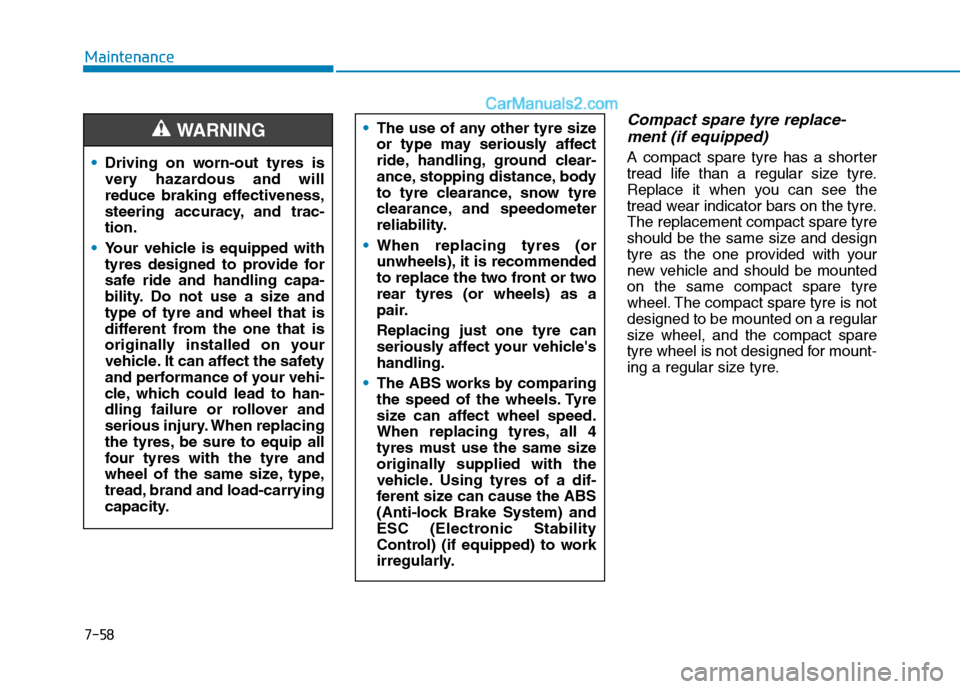
7-58
Maintenance
Compact spare tyre replace-
ment (if equipped)
A compact spare tyre has a shorter
tread life than a regular size tyre.
Replace it when you can see the
tread wear indicator bars on the tyre.
The replacement compact spare tyre
should be the same size and design
tyre as the one provided with your
new vehicle and should be mounted
on the same compact spare tyre
wheel. The compact spare tyre is not
designed to be mounted on a regular
size wheel, and the compact spare
tyre wheel is not designed for mount-
ing a regular size tyre. The use of any other tyre size
or type may seriously affect
ride, handling, ground clear-
ance, stopping distance, body
to tyre clearance, snow tyre
clearance, and speedometer
reliability.
When replacing tyres (or
unwheels), it is recommended
to replace the two front or two
rear tyres (or wheels) as a
pair.
Replacing just one tyre can
seriously affect your vehicle's
handling.
The ABS works by comparing
the speed of the wheels. Tyre
size can affect wheel speed.
When replacing tyres, all 4
tyres must use the same size
originally supplied with the
vehicle. Using tyres of a dif-
ferent size can cause the ABS
(Anti-lock Brake System) and
ESC (Electronic Stability
Control) (if equipped) to work
irregularly.Driving on worn-out tyres is
very hazardous and will
reduce braking effectiveness,
steering accuracy, and trac-
tion.
Your vehicle is equipped with
tyres designed to provide for
safe ride and handling capa-
bility. Do not use a size and
type of tyre and wheel that is
different from the one that is
originally installed on your
vehicle. It can affect the safety
and performance of your vehi-
cle, which could lead to han-
dling failure or rollover and
serious injury. When replacing
the tyres, be sure to equip all
four tyres with the tyre and
wheel of the same size, type,
tread, brand and load-carrying
capacity.
WARNING